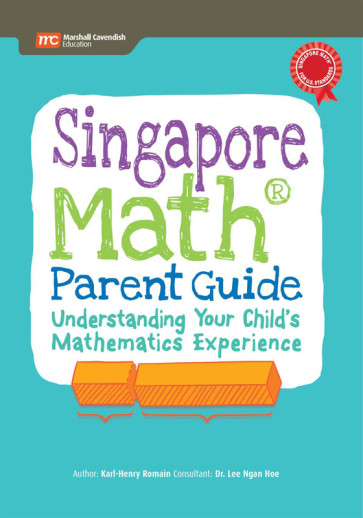We use cookies to make your experience better. To comply with the new e-Privacy directive, we need to ask for your consent to set the cookies. Learn more.
Singapore Math Parent Guide
Confused by the “new way” of doing math? It’s frustrating when the methods used in your child’s curriculum aren’t what you remember. No fear, Singapore Parent Guide to the rescue! This easy-to-understand resource explains the reasons and techniques behind the Singapore methodology, helping you gain the confidence you need. You’ll gain an appreciation for the way students move through the stages of “Concrete, Pictorial, Abstract” and methods such as bar modeling and number bonds, which help them look at problems from many different angles, gaining a deeper understanding of math. 124 pgs, pb. ~Nancie
Countries around the world first became interested in Singapore's math curriculum when results of the Third International Math and Science Study (TIMSS) were published in 1995. Conducted by the International Study Center at Boston College, achievement tests in both math and science were administered to students in over 40 countries. Students from Singapore ranked highly in mathematics achievement: 1st in the fourth, seventh, and eighth grade levels and 2nd at the third grade level. Results for the U.S. were disappointing: 10th in the third grade, 11th in the fourth grade, 23rd in the seventh grade, and 27th at the eighth grade level. In a follow-up study in 1999, Singapore again ranked 1st in eighth grade math achievement while U.S. eighth graders ranked 19th. Although a first place ranking does not necessarily imply the best program, something about Singapore's math program was working.
"Singapore Approach Math" is a general term referring to a type of mathematical instruction (i.e. curriculum) developed from a syllabus designed by Singapore's Ministry of Education in the 1980s. There were a number of revisions and the 3rd edition was the last edition used in Singapore. The good test scores were associated with this material and all of our Singapore Approach Math programs are based primarily on the 3rd edition although it is no longer available for sale. Components from different editions are not interchangeable but a student can move between the editions in-between levels.
Primary Math US (1-6) is an adaptation of the 3rd edition for use in the U.S. Although a small amount of content (division of fractions) from the 2nd edition was added back into the US edition, it is almost identical to the 3rd edition. The US edition adds sections for U.S. customary measurements and uses U.S. spelling and conventions. We expect this edition to be available indefinitely. ©2003
Primary Math S/E (Standards Edition) (K-6) was adapted to meet the pre-Common Core CA math standards. An additional amount of content (probability, data analysis, negative numbers, coordinate graphing) from the 2nd edition was added back in and topics were rearranged but it is similar to the US edition. Cumulative Reviews at the end of each Unit and practice sets within each unit were added. Textbooks are in color. ©2008 This edition includes Earlybird Kindergarten Math.
Primary Math CC (Common Core) (K-5) is aligned to the Common Core State Standards and is another adaptation of the 3rd edition. Only minor changes were made to the scope and sequence. Unit Reviews are no longer cumulative and Practices were removed although some of the content was incorporated into the lessons. ©2014 Includes Earlybird Kindergarten Math CC. This edition will be available for the foreseeable future.
Primary Math 2022 Edition (K-5) is a completely new revision retaining all the excellent teaching methods of the earlier Primary Math programs. Incorporating both cumulative assessments and challenging problem solving, mastery learning is emphasized. The scope and sequence is similar to previous editions and topics are aligned to state and national standards. ©2021-2022
New Elementary Math (7-8) is a no-frills program based on an older Singaporian program and covering integrated algebra and geometry. It's considered a sequel to the Primary Math programs.
Math in Focus (K-8) was developed by Great Source (a division of Houghton Mifflin Harcourt) in conjunction with Marshall Cavendish (the original publisher in Singapore). Although the basic instructional sequences are similar and the content is very close to the SE, material added to the most recent editions brings it into alignment with CC. Math in Focus has a more American look and "feel." ©2010, 2014
View the Singapore Approach Math Comparison Chart.
| Product Format: | Paperback |
|---|---|
| Brand: | Marshall Cavendish Education |
| Grade: | AD |
| ISBN: | 9789814684064 |
| Length in Inches: | 8.375 |
| Width in Inches: | 5.875 |
| Height in Inches: | 0.25 |
| Weight in Pounds: | 0.4 |

